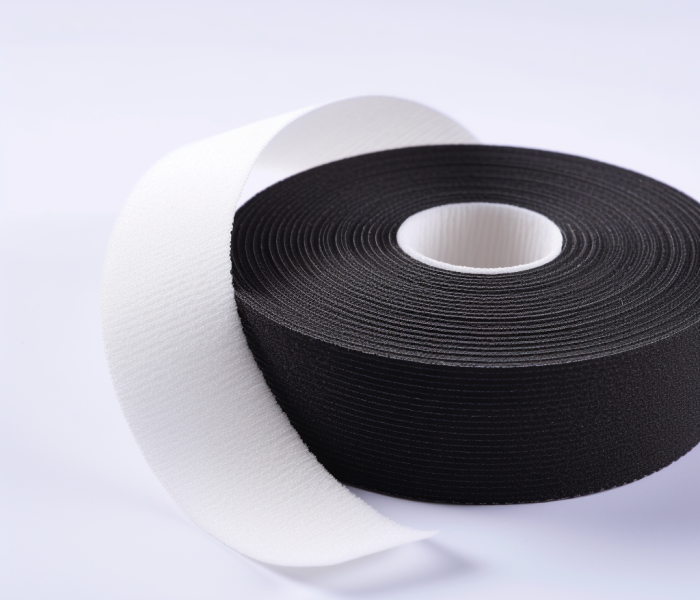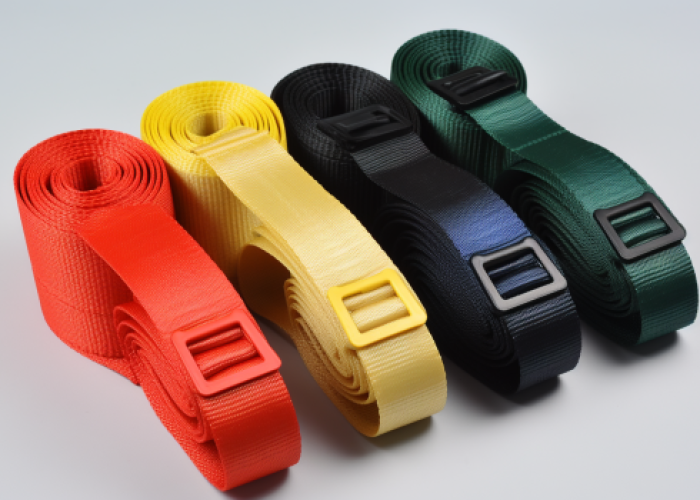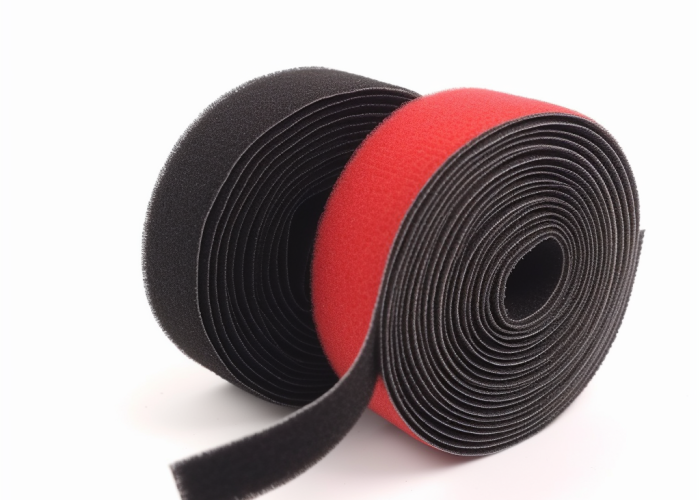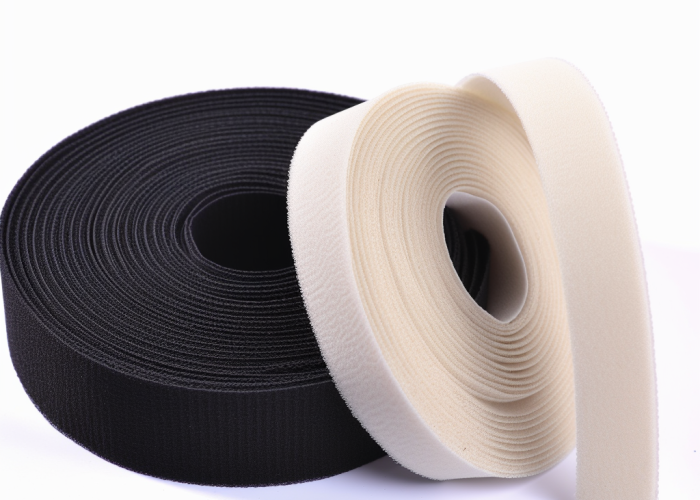Creating custom branded EZ straps requires specialized knowledge of materials, manufacturing processes, and regulatory requirements. As a professional webbing manufacturer, we provide comprehensive customization solutions for branded EZ straps across medical, industrial, and consumer applications.
To customize a branded EZ strap, select your materials, specify dimensions, add branding, choose finishes, and integrate fasteners. The process involves custom cutting, assembly, and quality control to ensure your final product meets both branding requirements and functional standards.
Explore key design factors for custom EZ straps, compare material options by application, and get step-by-step guidance from selection to production.


Webbing manufacturing expert with 15+ years of experience helping product developers build high-performance straps for industrial, medical, and outdoor use.
The primary materials for custom EZ straps are nylon and polyester webbing, with hook and loop fasteners. Your selection should be based on the strap’s intended use, required durability, and specific performance characteristics for your medical application. All our materials meet OEKO-TEX® STANDARD 100, ROHS, and REACH requirements for safe skin contact in medical applications.
Key considerations at a glance:
Nylon webbing offers excellent strength-to-weight ratio with natural elasticity, making it ideal for patient restraints where some give benefits comfort while maintaining security. Polyester alternatives provide superior UV resistance and minimal stretch, better suited for fixed-position applications where dimensional stability is crucial. Both materials can meet biocompatibility standards, with polyester offering better resistance to frequent sanitization.
Width selection impacts both patient comfort and restraint effectiveness. The 1.5″ width has become the industry standard for most adult patient restraints, providing optimal balance of comfort and security, while 2″ width is preferred for bariatric applications or when distributing pressure across larger areas is essential.
Color options typically include standard medical white (easiest to inspect for cleanliness) or black. Antimicrobial treatments can be applied to any color, adding approximately 15-20% to base material costs but extending product lifespan in healthcare settings.
Style considerations significantly impact functionality: buckle designs offer quick-release capabilities essential for emergency situations, hook-strap configurations provide secure fastening for critical applications, while tear-away designs offer safety release under specific load conditions – a critical feature for certain patient safety protocols.
For budget planning, request material samples to evaluate performance characteristics before committing to full production, especially when selecting between nylon and polyester for specific medical applications.
Different EZ strap materials offer distinct performance characteristics that directly impact their suitability for specific applications. Understanding these differences helps you select the optimal material for your unique requirements, ensuring both functionality and cost-effectiveness.
Performance Factor Nylon Polyester
Tensile Strength 20–30% higher than polyester Consistent under sustained load
Moisture Absorption 4–7% Less than 0.4%
Wet Strength Loss Up to 15% Only 5%
Flex Durability 5,000+ cycles 3,000+ cycles
Chemical Resistance Moderate Excellent
UV Resistance Lower Higher
Cost Efficiency Lower initial, higher lifetime Higher initial, lower lifetime
Nylon webbing demonstrates superior performance in applications requiring dynamic loading and flexibility, making it the preferred choice for patient transfer straps and emergency restraints where sudden forces may occur. Meanwhile, polyester excels in environments requiring dimensional stability and resistance to frequent sanitization.
For pediatric applications, softer-edge finishes and lighter weight materials significantly improve patient comfort while reducing pressure injury risks, with specialized medical-grade weaves creating a 25-40% larger surface area for pressure distribution without compromising tensile strength.
Applications requiring antimicrobial properties show 99.9% reduction in bacterial growth on treated polyester surfaces after 24 hours, with treatments remaining effective through 50+ industrial washing cycles.
While medical-grade polyester typically costs 15-20% more than standard nylon initially, its extended usable life often results in 30% lower total ownership costs over a 3-year period in high-use settings.
Medical grade EZ straps must meet strict requirements for patient safety, including biocompatibility, skin-friendly materials, and compliance with regulatory standards. These requirements ensure straps perform reliably in healthcare environments while protecting patient welfare.
Requirement Category Standard/Specification Importance
Biocompatibility ISO 10993 Mandatory for skin contact
Latex Content Zero latex proteins Prevents allergic reactions
Material Certification OEKO-TEX®, ROHS, REACH Required for medical use
Sanitization Compatibility 10% sodium hypochlorite, 70% alcohol Essential for infection control
Fastener Durability Hook-and-loop systems should maintain ≥50% peel/shear strength post-sanitization; top-grade systems can retain 70–80% over 1,000 cycles Industry standard threshold
Manufacturing Process ISO 13485 Ensures consistent quality
Medical-grade EZ straps must be manufactured from completely latex-free materials to prevent allergic reactions affecting approximately 4.3% of healthcare workers and 1.2% of patients, with materials tested to confirm zero latex proteins. Biocompatibility testing according to ISO 10993 standards confirms materials do not cause cytotoxicity, sensitization, or irritation—mandatory for any strap making direct patient contact.
Materials must withstand rigorous cleaning protocols, including exposure to hospital-grade disinfectants without degradation, with polyester generally outperforming nylon in chemical resistance testing. Durability requirements specify medical EZ straps maintain functionality through a minimum of 500 use cycles, with hook and loop fasteners maintaining at least 50% of original engagement strength after repeated cleaning—exceeding the industry minimum standard of 40%.
Regulatory compliance extends beyond material selection to manufacturing processes, with ISO 13485 certified production ensuring consistent quality and traceability. When selecting medical-grade straps, verify that suppliers provide comprehensive testing documentation rather than relying solely on material data sheets.
Custom EZ straps can be branded through techniques including pad printing, UV printing, dye sublimation, embossing, or laser etching. Each method offers different advantages in durability, color options, and cost-effectiveness depending on your branding requirements.
Branding method overview:
Pad printing represents the most common branding method, offering 1-3 Pantone-matched colors with excellent durability, with prints retaining 85-90% visibility after 500 wash cycles. Production setup costs typically range from $50-150 depending on logo complexity, making this ideal for medium to large production runs.
UV printing provides superior detail reproduction and full-color capability, allowing for gradient effects and photographic reproduction that pad printing cannot achieve. While slightly more expensive (adding approximately $0.15-0.30 per strap), this method enables vibrant branding that enhances product recognition. For optimal results, supply your logo in vector format (AI, EPS, or PDF) with a minimum resolution of 300 DPI.
For maximum durability in demanding medical environments, consider embossed branding, which creates a raised or recessed logo without using inks or dyes. This method permanently alters the strap material, ensuring brand visibility throughout the product’s entire lifecycle regardless of cleaning regimen. The initial tooling cost ($200-350) makes this most economical for larger production runs.
Standard positioning typically occupies a 2-4 cm² area at no additional cost, while full-length custom branding may incur a 10-15% premium. For color selection, consider institutional branding requirements while recognizing that darker webbing materials limit color options. White, black, and primary colors demonstrate the highest visibility across multiple material colors.
When submitting artwork, provide vector files whenever possible and include detailed color specifications using Pantone (PMS) codes rather than RGB or CMYK values to ensure color accuracy across production batches.

EZ strap surface treatments and finishing options include edge finishing, antimicrobial coatings, softening treatments, and specialized coatings for enhanced functionality. These finishing processes significantly impact comfort, durability, and performance in medical applications.
Available finishing options:
Edge finishing techniques prevent fraying while significantly impacting comfort and durability. Ultrasonically sealed edges offer the cleanest finish, reducing edge thickness by 25-30% compared to conventional cutting methods while increasing edge strength by 40-50%. This creates a smooth, sealed edge that prevents skin irritation – critical for direct patient contact.
Antimicrobial treatments incorporate EPA-registered additives that inhibit bacterial growth by up to 99.9% on strap surfaces, withstanding 75+ hospital laundry cycles while maintaining effectiveness. These treatments add approximately $0.10-0.25 per strap depending on application method and coverage area.
Softening treatments significantly improve patient comfort by reducing initial stiffness. Mechanical softening achieves a 30-40% reduction in flexural rigidity without compromising structural integrity, while enzyme washing creates an ultra-soft surface texture ideal for pediatric or geriatric applications where skin sensitivity is paramount.
Specialized coatings can enhance functional performance, including fluid-resistant finishes that maintain dry surface conditions even when exposed to 100ml of fluid contact. Grip-enhanced coatings increase friction coefficient by 35-45%, preventing slippage during patient movement without causing skin irritation.
Pattern embossing offers both functional and branding opportunities, with textured surfaces providing improved air circulation between strap and skin, reducing moisture buildup by up to 40% in extended wear testing. Consider requesting sample swatches with different finishes before final selection to evaluate performance characteristics in your specific application.
Hook and loop fasteners are integrated into EZ straps through stitching, RF welding, or adhesive bonding, with positioning customized based on application requirements. The integration method significantly impacts strap performance, durability, and user experience.
Integration Method Durability Appearance Water Resistance Cost Best For
Stitching Highest tensile strength (50+ lbs) Visible threads Good Mid-range General medical use
RF Welding Excellent (40+ lbs) Seamless Excellent Higher Frequent sanitization
Adhesive Bonding Good (30+ lbs) Minimal visibility Variable Lowest Cost-sensitive applications
Hybrid Methods Very high (45+ lbs) Customizable Very good Higher Critical applications
The hook and loop sections are typically positioned either at opposite ends of the strap (wrap-around configuration) or with hook on one side and loop on the reverse (fold-over design). The fold-over design reduces total strap length requirements by 30-40% while providing more secure closure for applications with limited space.
Stitching uses high-tensile polyester thread in box-X or double-line patterns to create bonds that withstand 50+ pounds of direct pulling force. Medical-grade applications typically utilize antimicrobial threads that maintain 95% strength after 200+ cleaning cycles. RF welding creates seamless integration without visible stitching by fusing materials at the molecular level, producing a completely waterproof bond with no thread deterioration risk.
Engagement strength varies significantly between fastener grades, with medical-grade hook and loop maintaining 75-90% of original closure strength after 1,000+ open/close cycles compared to standard grades retaining only 40-60%. This performance difference justifies the 20-30% higher material cost for critical medical applications.
Proper hook-to-loop ratio is essential for optimal performance, with most medical applications requiring a 1:3 ratio to ensure secure closure while accommodating size variations. This ratio provides approximately 2″ of adjustment range for every 1″ of hook surface, allowing for swelling accommodation and positioning flexibility.
Specialized features available include antimicrobial-treated fasteners, low-profile hooks for reduced skin irritation, and color-coded sections for proper application identification, adding minimal cost (5-15%) while significantly improving clinical usability and patient outcomes.
The manufacturing process for custom EZ straps involves material selection, cutting, fastener integration, quality control, and final inspection to ensure consistent performance. Each step utilizes specialized equipment and precise procedures to meet medical-grade specifications.
Manufacturing process overview:
The process begins with material selection and preparation, where raw webbing undergoes testing for tensile strength, elongation, and dimensional stability. Medical-grade materials require certification verification and lot tracking to ensure complete traceability throughout the manufacturing process.
Precision cutting utilizes computer-controlled equipment maintaining ±1mm tolerance across production runs. This precision ensures consistent performance and interchangeability – critical factors for medical applications where dimensional accuracy directly impacts patient safety and comfort.
Fastener integration follows strict procedural controls with tension monitoring during attachment to prevent material distortion while ensuring optimal fastener engagement. For stitched attachments, automated tension control maintains consistent thread pressure, significantly reducing performance variation between finished units.
Quality control occurs at multiple stages throughout production, with both automated and manual inspection points. Automated vision systems verify dimensional accuracy and fastener placement with 0.5mm precision, while manual inspection confirms surface finish quality and edge treatment effectiveness. Statistical sampling follows ANSI/ASQ Z1.4 guidelines, with medical-grade products typically requiring AQL levels between 0.65-1.0.
Surface treatments and finishing processes occur after primary assembly but before final inspection, allowing verification that treatments have been properly applied without affecting structural components. Final inspection includes functional testing where each fastener is engaged and disengaged multiple times to verify proper operation, with load testing performed on statistical samples to confirm weight-bearing capacity.
The entire manufacturing process typically requires 5-10 business days depending on complexity and quantity, with larger orders (1,000+ units) potentially requiring 15-20 business days. Medical-grade products undergo additional quality verification, potentially extending production timelines by 3-5 business days.

The cost and timeline for custom EZ straps are influenced by material selection, quantity, customization complexity, quality requirements, and production scheduling. Understanding these factors helps you plan effectively for both budgeting and project timelines.
Key cost and timeline factors:
aterial selection represents the most significant cost factor, with medical-grade materials commanding a 30-50% premium over standard industrial grades due to more rigorous testing and certification requirements. Higher performance specifications like antimicrobial treatment add 15-25% to base material costs.
Quantity dramatically impacts per-unit pricing, with price breaks typically occurring at 250, 500, and 1,000 units. Orders exceeding 1,000 units generally realize 25-35% lower per-unit costs compared to smaller quantities due to more efficient material utilization and reduced setup time allocation per unit.
Customization complexity affects both cost and production timeline. Standard sizes and configurations typically ship within 5-7 business days, while highly customized designs requiring special tooling may require 15-20 business days for initial production. Subsequent orders of identical specifications typically ship 30-40% faster than initial production runs.
Branding complexity influences both setup costs and production timelines. Simple single-color logos add minimal cost ($0.15-0.30 per unit) and production time, while multi-color or specialized printing techniques may add $0.50-1.00 per unit and extend production by 3-5 business days. Initial setup fees for new artwork range from $50-200 depending on complexity.
Quality certification requirements for medical applications add both cost and time to the production process. Full documentation packages including material certifications, biocompatibility testing, and process validation add approximately 15-20% to total costs while extending lead times by 5-7 business days for complete verification.
For budget-sensitive projects, consider standardizing dimensions and reducing customization complexity, which can lower costs by 20-30% while maintaining essential functionality. Combining orders to meet higher quantity breakpoints often delivers better overall value despite higher initial investment.
A complete EZ strap design must balance material properties, fastening system, ergonomics, regulatory compliance, and branding requirements. Integrating these elements creates a strap that performs reliably while enhancing brand identity and user experience.
Essential design considerations:
Application-specific requirements should drive initial design decisions, with clear definition of load capacity, flexibility, and environmental exposure conditions. Medical applications typically require higher safety factors (1.5-2.0x calculated load) compared to general-purpose straps, with material selection directly impacting safety margins.
User interaction points deserve particular attention, as improper ergonomics can impact both user satisfaction and patient outcomes. Fastener positioning should account for user dexterity limitations, with medical applications typically requiring operation with a single hand or while wearing gloves. Design features like pull tabs or extended grip areas add minimal cost (3-7%) while significantly improving usability.
Environmental factors impact material longevity, with temperature extremes potentially reducing material strength by 15-25% at boundaries of operating ranges. Chemical exposure from cleaning agents requires specific material compatibility testing, with polyester generally maintaining 90-95% of properties after repeated exposure compared to nylon’s 75-85%.
Regulatory compliance should be integrated from initial design rather than addressed retroactively. Medical-grade applications require comprehensive documentation tracing materials from source through finished product, with clear identification of all components, processes, and quality controls. Building these requirements into initial design specifications reduces compliance costs by 40-60% compared to post-design modifications.
Brand integration opportunities exist beyond simple logo placement. Consider color-coding for size identification, embossed patterns incorporating brand elements, or custom weaving patterns that enhance both functionality and brand recognition. These integrated approaches create distinctive products without compromising performance.
Balance between cost and performance requires prioritizing critical elements while identifying areas where standard options provide acceptable performance. In medical applications, fastener quality and material grade should rarely be compromised, while customization in areas like edge finishing or packaging may offer cost-saving opportunities with minimal impact on core functionality.

Creating custom branded EZ straps requires careful consideration of materials, specifications, medical requirements, and manufacturing processes. By understanding these key factors, you can develop high-performance straps that enhance your product’s functionality and brand identity. Contact us to explore manufacturing solutions tailored to your specific product requirements.
Quality testing includes tensile strength testing, fastener cycle testing, and dimensional verification. Every production batch undergoes statistical sampling according to ANSI/ASQ Z1.4 guidelines. Medical-grade products receive additional biocompatibility verification, sanitization resistance testing, and complete traceability documentation to ensure compliance with applicable standards.
es, production scaling is readily accommodated with minimal transition costs. We maintain complete specifications and production data for all custom designs, allowing seamless scaling from initial runs to high-volume production. Material consistency and manufacturing processes remain identical regardless of quantity, ensuring consistent performance.
Yes, MOQs vary based on customization level. Standard configurations require 100-unit minimums, while fully customized designs with specialized materials or treatments typically require 250-500 units. Volume discounts begin at 500 units with significant price breaks at 1,000+ units.
The ordering process involves specification submission, sample approval, and production confirmation. After receiving your requirements, we produce samples for your evaluation within 3-5 business days. Upon approval, full production begins with standard lead times of 10-15 business days depending on quantity and specifications.
Yes, custom EZ straps can be designed for compatibility with specific medical equipment. We can create custom attachment points, specialized fastening systems, and precisely calibrated tensioning mechanisms to integrate with imaging equipment, patient transfer devices, or monitoring systems while maintaining medical-grade standards.
Durability testing includes cycle testing, load testing, and accelerated aging. Medical-grade nylon straps typically maintain 90%+ functionality through 1,000+ use cycles, while high-performance polyester options can withstand 1,500+ cycles. Proper care can extend useful lifespan to 3+ years in typical clinical settings.